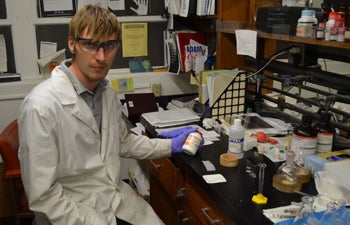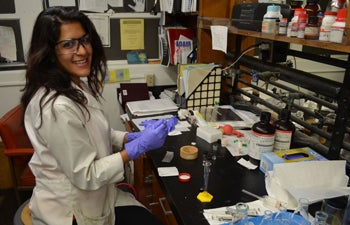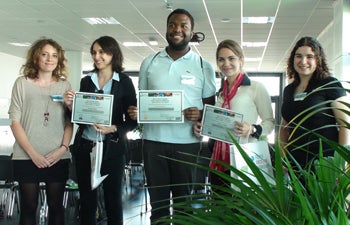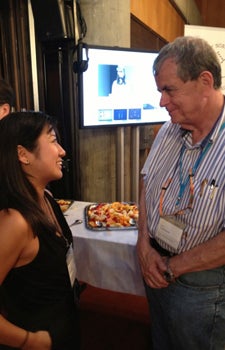Fourfold Excellence
Postdoctoral research associate Ivan Krylov and Ph.D. chemistry students Melissa Williams, Candy Hwang and Elena Ferri have more than one thing in common.
They all work in the laboratory of Charles McKenna, vice dean for natural sciences, professor of chemistry, pharmacology and pharmaceutical sciences at USC Dornsife — and they were all recognized this summer for the quality of their research.
Krylov and Williams were honored by the International Society for Antiviral Research (ISAR) for excellence in scientific poster presentations at the society’s annual international conference (ICAR), held this year in San Francisco, CA.
The ISAR awards recognize young investigators for their outstanding contributions to antiviral research. Typically more than 200 presentations are made of which around a quarter are by Ph.D. students and postdocs. Awards are based on criteria including scientific excellence, innovative research methodology, and clarity and organization of presentation materials.
Krylov, who earned a Ph.D. in chemistry from USC Dornsife in 2012, almost missed learning of his win as he had to leave the closing award banquet early to catch a plane back to Los Angeles. As he was leaving, he ran into an organizer.

Postdoctoral research associate Ivan Krylov works in the Charles McKenna lab, optimizing the therapeutic potential of antiviral drugs. Photo by Erica Christianson.
“It would be a shame if I won the award and was not there to receive it,” he joked to the organizer, who immediately asked him to stay put. She returned a few minutes later with a member of the poster award committee who let Krylov know they had awarded him second prize in the postdoctoral category.
“I felt very surprised, excited and speechless because it was absolutely unexpected.” Krylov said. “It is especially flattering to receive such recognition from your peers, the people who work in the same field with you and, in a way, compete against you.”
He said his multidisciplinary award would not have been possible without the collaboration of many researchers. Both Krylov and Williams’ research was financially supported by the National Institute of Health (NIH).
Krylov’s project aimed to optimize therapeutic potential of two antiviral drugs, cidofovir and (S)-HPMPA, that are active against a number of DNA viruses, including human cytomegalovirus (HCMV), vaccinia and cowpox.
These drugs correspond to the class of acyclic nucleoside phosphonates (ANPs) and mimic the metabolism of natural nucleoside monophosphates, DNA building blocks. Although differing in structure from their natural counterparts, ANPs can still be incorporated into viral DNA. Upon incorporation, they terminate further elongation of the DNA chain causing viral cell death. ANPs are very powerful antiviral agents but their therapeutic potential is significantly hampered due to their low cell membrane permeability and nephrotoxicity owing to their ionization at physiological pH.
In order to ameliorate these drawbacks of the ANPs, Krylov is developing an amino acid-based prodrug approach. Recently, he developed prodrugs that showed dramatically enhanced antiviral and pharmacokinetic properties compared to the parent drugs, cidofovir and (S)-HPMPA: up to 10,000-fold increased potency against human cytomegalovirus, up to 1,000 times improved activity against orthopox viruses (vaccinia, cowpox), and up to 10-fold greater oral bioavailability. Currently selected prodrugs have been approved by the NIH to be tested in vivo.
“These remarkable results render the newly designed prodrugs as promising drug candidates,” Krylov said. “They have the potential to reach the clinic and be used as highly effective orally deliverable treatment for HCMV, smallpox, vaccinia and other related viral diseases.
Krylov said he feels fortunate to study and conduct research at USC.
“During the past six years, I’ve been surrounded by knowledgeable and passionate researchers,” he said. “I receive guidance, support and encouragement. In addition to chemistry I’m learning the values of collaboration and excellence in scientific writing.”

Graduate student Melissa Williams investigates the potential of ANPs prodrugs as effective treatments for DNA viruses and retroviruses, including HIV. Photo by Erica Christianson.
Williams said winning the award had been “simultaneously unexpected and pretty amazing.”
Williams’ poster, which won second prize in the Ph.D. student category, showed her research into the synthesis and antiviral activity of a small collection of acyclic nucleoside phosphonate prodrugs as antiviral agents.
Williams said she valued her experience at USC Dornsife as well.
“Being accepted into the graduate program of this prestigious university has given me the chance to make a contribution to the field of medicinal chemistry,” Williams said. “I can participate in national and international scientific collaborations and meetings, as well as cultivate my professional growth as a scientist in chemistry.”
Ph.D. student Elena Ferri received a Best Poster Award at the French American Workshop held in Grenoble, France, in July.

USC Dornsife Ph.D. student Elena Ferri (second from left) with fellow prize winners at the French American Workshop in Grenoble, France, where she was recognized for her poster explaining chromatin remodeling. Photo courtesy of the French-American Workshop.
Ferri’s research, a French-American collaboration on chromatin remodeling proteins, is supported by Partner University Fund, a Chateaubriand Fellowship, USC Dornsife and the French National Center for Scientific Research (CNRS).
Her entry was based on a collaboration among the McKenna lab and two laboratories in Grenoble headed by Carlo Petosa and Jerome Govin.
“The award recognized our work and efforts to bring an American and two French labs together in a challenging project on epigenetics applied to drug discovery at the interface of chemistry, chemical biology and crystallography,” Ferri said. “As this was the first poster I have done in my Ph.D. career, it was also very rewarding to see it honored among more than 30 posters present at the workshop.”
Ph.D. student Candy Hwang was among 625 young researchers from 78 countries selected from a pool of more than 20,000 applicants worldwide to participate in the 2013 Nobel Laureate Lindau Meeting, where in July, 34 Nobel laureates congregated in Lindau, Germany, to meet the next generation of leading scientists and researchers.
At the meeting, Hwang was one of three students selected to participate in a debate series filmed by Nature. Their debate with two Nobel laureates, Gerhard Ertl (Nobel Prize in Chemistry in 2007) and Robert Grubbs (Nobel Prize in Chemistry in 2005), focused on the future of catalysis in the face of the world’s dwindling supply of rare-earth metals.

Ph.D. student Candy Hwang engages in a one-on-one conversation with Aaron Ciechanover, winner of the 2004 Nobel Prize in Chemistry, at this summer’s Nobel Laureate Lindau Meeting. Photo by Robert Gilliard.
Supported by the National Science Foundation and USC Dornsife, Hwang’s research focuses on elucidating the mechanism of nitrogenase, a complex enzyme important for food sustainability, that uses a unique metal cofactor. She was elated when she learned she had been selected.
“I felt very lucky to be able to participate in an almost one-on-one discussion with two Nobel laureates,” Hwang said. “At the same time, I thought it would be rather intimidating to debate the chemistry of catalysis with these experts. I got over my initial fears and really loved the experience. As young students, we had the opportunity to voice our concerns about the future use of rare-earth catalysts and ask their thoughts on the issue.
“Toward the end of our time together, they encouraged us to continue pursuing our passion for chemistry,” Hwang said. “I think this debate was a once-in-a-lifetime opportunity and one that I will cherish throughout my career as a scientist.”